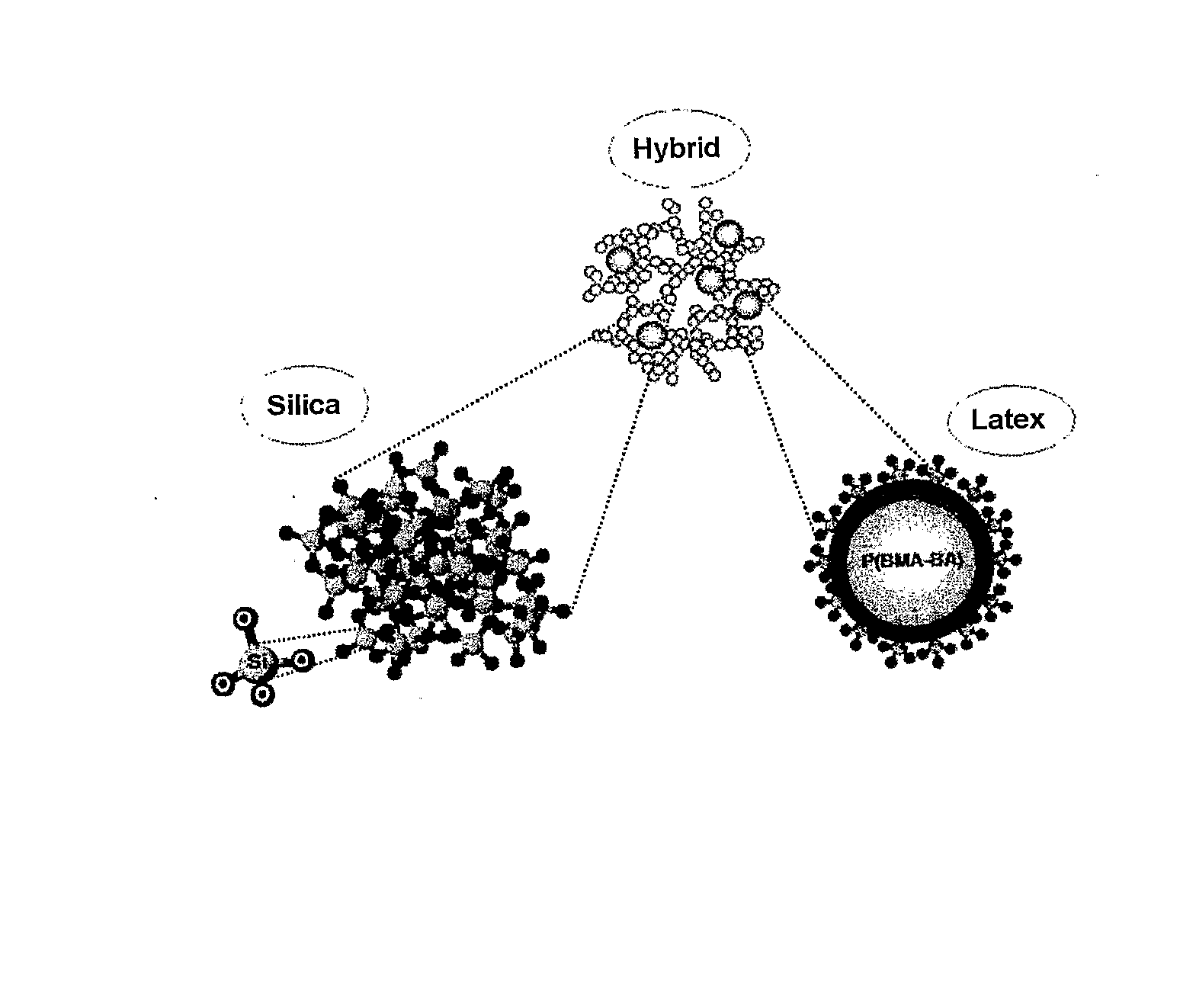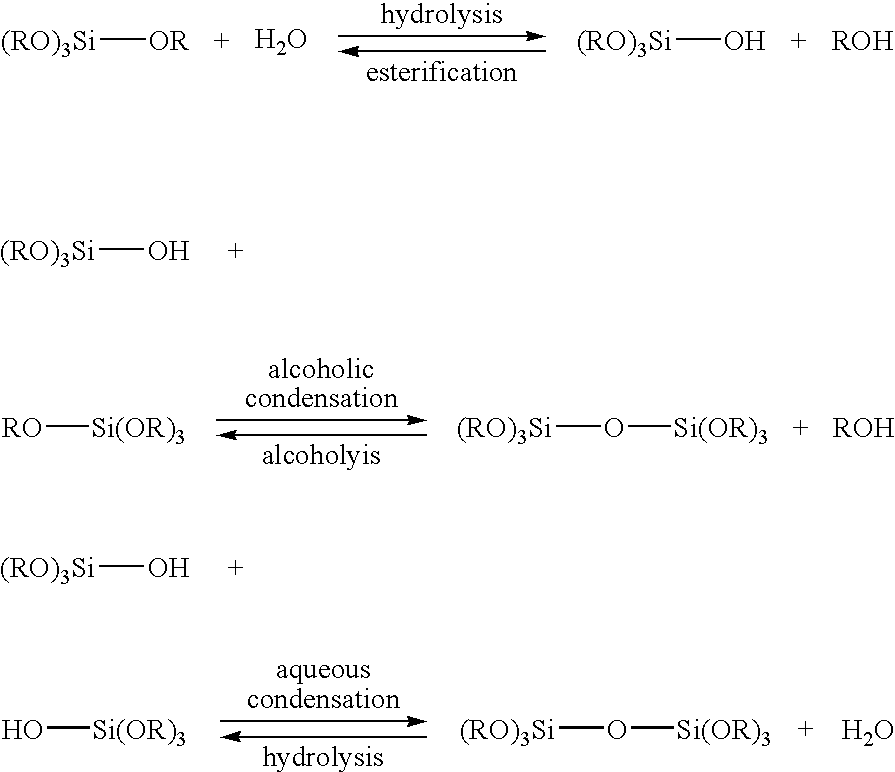The conventional insulators, such as
mineral wool and expanded polymers do not meet these requirements.
The production of mineral
wool needs high temperatures, and involves the formation of undesirable residues.
However, these insulators are harmful to the environment, because the
blowing agent slowly escapes from them into the
atmosphere.
Non-halogenated blowing agents have a less polluting effect, but cause problems in the preparation and use of plastic foams, since they are flammable.
Furthermore, the plastic foams are not biodegradable and have a short service life, rendering them unsuitable for many applications.
However, these materials have a low compression strength and are fragile.
This is an efficient method, but the salts formed as by-products inside the gel have to be removed by several washing cycles, which is a long and laborious operation.
However, it has been generally found extremely difficult to use the
sol-gel process for making large monolithic pieces that have a high
porosity and no cracks.
Since the extremely porous structure of the wet gel has a low
mechanical strength, the resulting
capillary pressure can be strong enough to make the network collapse and the product crack.
Furthermore, the capillary forces can greatly reduce the volume of the gel, leading to a
partial loss of its intrinsic
porosity.
However, though efficient, this method is dangerous and expensive, partly because generally high temperatures and pressures are used in it, and partly because the equipment needed is relatively costly and the intermediate steps are slow and complicated.
The monolithic pieces of silica
aerogel obtained here are therefore generally small, owing to the high cost of large autoclaves.
Besides, according to the literature, the monolithic
aerogel pieces made by this method are very fragile.
However, although the cost of the
autoclave is greatly reduced when working under milder conditions, the compressor needed to liquefy
carbon dioxide and the cryogenic equipment needed to keep it in the
liquid state are still very expensive.
However, this method is also very sluggish, owing to the
solvent substitution process involved, which is limited by
diffusion.
The subcritical method used for the preparation of silica aerogels does involve some problems due to the formation of liquid / vapour interfaces, mentioned above.
The structure of the gel is eventually compressed, with a considerable loss of volume, and a significant loss of porosity, a xerogel being obtained instead of an
aerogel.
Although this method can be used to prepare samples of a small size, i.e. silica aerogel particles, it has never been shown to give monolithic pieces that are free of cracks.
This method is generally efficient in the preparation of crack-free monolithic pieces, but it can be very slow, and over a month may be needed to complete the
drying process.
However, the most efficient silylating agents are chlorinated compounds, and their use involves undesirable environmental hazards, such as the release of HCl and the formation of various by-products.
This calls for a lengthy washing procedure in order to purify the gels, which is both slow and costly.
Besides, the products must be particularly resistant to
corrosion here, and the associated safety measures call for highly complex and expensive equipment.
However, these are not as efficient, because their hydrophobic groups are bound to the silica via
oxygen bridges, which are easily cleaved by water.
Besides, most non-chlorinated silylating agents are unavailable on an
industrial scale, which greatly increases the cost of the process.
Furthermore, the aerogels modified with organic groups are not very strong mechanically and are easily broken.
However, this method has not been found to be particularly suitable for the preparation of large monolithic pieces, because no catalyst has been found that permits pores with a mean size greater than 10 nm to be obtained.
The introduction of
colloidal silica particles into the
sol also makes it possible to increase the mean pore
radius, but their presence means that the gel loses its homogeneous nature, which restricts the range of compositions that can be used (see for example U.S. Pat. No. 4,681,615).
This strengthens the matrix of the gel, but the method in question generally produces numerous bubbles in the monolithic pieces.
Suitable
ageing of the gel before the
drying operation is another method for increasing the mean
pore diameter of the wet gel, but the usual
ageing periods needed make for a long process and increase the cost of equipment (see for example International Patent WO 92 / 20623 and U.S. Pat. No. 5,023,208).
However, the synthesis of the wet gel takes several hours, and
ageing takes a long time—a week or more—at 70° C. In fact, most of the existing processes aimed at improving the
mechanical strength of the wet gel involve prolonged ageing and drying if crack-free monolithic pieces are to be obtained.
However, the size of the dry gels obtained here and the overall
process time are generally not disclosed.
However, organic resins and foams are flammable and reduce the insulating performance of the aerogel.
However, this preparation is costly, because it calls for large amounts of a supercritical aerogel in
powder form and involves a number of critical production steps.
Furthermore, the insulating properties of these materials tend to be less good than those of monolithic silica aerogels (see for example U.S. Pat. No. 6,479,416 B1).
However, the production process also includes
supercritical drying, which suffers from the technical problems and high cost mentioned before.
In fact, there has not so far been an efficient process for the preparation of large, crack-free monolithic aerogels under subcritical conditions in a reasonable space of time.
Nor has there so far been an efficient process for the preparation of these monolithic aerogels with a hydrophobic character and with the necessary mechanical properties for most practical applications.
 Login to View More
Login to View More 


